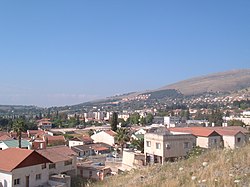Chatzor ha-Gelilit
Hatzor HaGlilit
|
|
|---|---|
| Hebrew transcription(s) | |
| • ISO 259 | Ḥaçor ha Glilit |
| • Also spelled | Hatzor HaGlilit (unofficial) |
 |
|
| Coordinates: 32°58′46.1″N 35°32′36.51″E / 32.979472°N 35.5434750°ECoordinates: 32°58′46.1″N 35°32′36.51″E / 32.979472°N 35.5434750°E | |
| District | Northern |
| Founded | 1953 |
| Government | |
| • Type | Local council |
| • Head of Municipality | Shimon Swisa |
| Area | |
| • Total | 5,170 dunams (5.17 km2 or 2.00 sq mi) |
| Population (2016) | |
| • Total | 9,004 |
| Website | http://www.hatzorg.co.il |
Hatzor HaGlilit (Hebrew: חָצוֹר הַגְּלִילִית) is a town in northern Israel near Rosh Pinna and Safed. It is named for the nearby biblical site of Tel Hazor. In 2016 it had a population of 9,004.
Hatzor was a Canaanite and later Israelite city within the tribe of Naphtali (Joshua 19:36) during late Bronze and early Iron Ages, which was conquered by Assyrian ruler Tiglath-Pileser III in 732 BC and its population was deported, while the city was burnt to the ground.
Hatzor HaGlilit was founded in 1952–1953 as a transition camp. The new founded camp was located on the land of the depopulated Palestinian village of Mughr al-Khayt, 1 km southeast of the village site. The two adjacent transition camps were initially named "Hatzor A" and Hatzor B", named for the nearby biblical site of Tel Hatzor, and housed immigrants and refugees, primarily Jews from North Africa.
In 1956, Hatzor HaGlilit was given the status of local council. By 1958, Hatzor HaGlilit had a population of 4,000 and received development town status. Over time, the city preserved its Jewish religious-traditional demographic status and later a Jewish ultra-orthodox neighbourhood was also established, housing Gur Hassids.
...
Wikipedia

